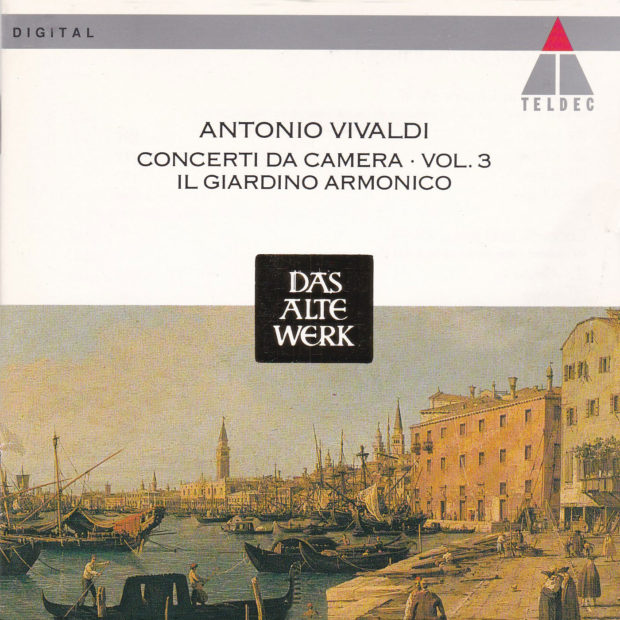The course of music history has taken surprising and, occasionally, truly strange turns. Thus, many a composer who was extremely popular and celebrated during his lifetime has been so completely forgotten since his death that he is only known today to music historians. In other cases, however, a small group of enthusiasts kept the memory of a composer’s works and contributions alive in the minds of a few, until interest in him was revived. Such was the case with Johann Sebastian Bach. His Italian contemporary, Antonio Vivaldi (1678 – 1741), met another fate however. For more than 150 years, only a handful of lexicographers, biographers and musicians preserved the reputation of the composer known as “Prete Rosso” (the red priest) on account of his red hair and clerical order.
In 1802, Johann Nikolaus Forkel wrote in his biography of Bach that the composer used “Vivaldi’s violin concerto (op. 3, 1711) that had recently been published as a study piece and arranged the entire work for piano”. Today, we know that 10 of Vivaldi’s 220 violin concertos served as models for Bach’s piano and organ transcriptions. The Venetian dramatist Carlo Goldoni, who occasionally collaborated with Vivaldi, tells us in his autobiography published in 1761 that the composer’s achievements were significant for the musical life of his home town. Nevertheless, Vivaldi’s music — his extensive oeuvre of chamber music, symphonic works, operas and sacred pieces — was forgotten and remained so until the beginning of this century. Change came about as scholars began researching the extant musical sources. Among musicians, interest in his compositions grew slowly at first. Since then, however, they have become increasingly enthusiastic, a development that allows us to speak of a virtual “Vivaldi Renaissance” today.
These events are all the more remarkable since the Italian composer’s works were widely disseminated throughout Europe during his own lifetime. Nowadays, Vivaldi’s works are prized possessions of the libraries in Dresden and Prague, as well as in the lower Franconian valley, Eisenstadt, and London. The first publication of Vivaldi’s music was printed by the Venetian Giuseppe Sala in 1705 and, in keeping with the practice, contained 12 trio sonatas. In 1711, Estienne Roger, the renowned Amsterdam printer, took over the publication of Vivaldi’s works. He was soon followed by the Londoner John Walsh, well-known as a patron of Handel. With respect to the printing practice, it was common at that time to produce pirate editions. Not surprisingly, opuses 11 and 12 were published by Roger in 1729. Thus, Vivaldi apparently “decided not to have any more concertos printed”, according to E. Holdsworth. On February 13, 1733, the latter informed his employer Charles Jennes in London of the reason for this decision: “He (Vivaldi) said, that would hamper the sale of his compositions in manuscript.” Nothing changed afterwards. This explains why the majority of Vivaldi’s works were never published.
Indeed, they were never published, but the works were still handed down. Vivaldi was a much sought-after teacher. Many people were willing to make the hard journey across the Alps in order to perfect their skills in Venice. Included among Vivaldi’s students were Johann Georg Pisendel, who became a famous concertmaster at the Saxon court, and the conductor of the court orchestra at Gotha Gottfried Heinrich Stoelzel. Naturally, they returned with works by the revered teacher in their baggage. Owing to this, the Saxon State Library in Dresden has a considerable amount of Vivaldi’s music.
The pieces on this recording number among the group of unpublished works. As a result, the dates of their composition are obscure. The only date which can be determined is the year the D-major Concerto RV 93 was composed. The autograph score preserved in Turin was written on comparably unusual paper. It contains an entry on the first page “Per Sua Eccelenza Signor Conte Wrttbij” (for His Excellency Count Wrttbij). The Vivaldi scholar Michael Talbot believes that it was intended for the Bohemian music connoisseur, royal governor and head of the court judiciary Count Johann Joseph von Wrtby. He and Vivaldi met in Prague at the performance of the composer’s opera Farnace in 1730/31. Although Vivaldi maintained lifelong ties to the famous Ospedale della Pietà (by modern standards, a conservatory for girls only) where he began teaching in 1704, he often interrupted his duties as violin teacher and, later, as “Maestro de Concerti” in order to travel. The other concertos were evidently conceived with the special conditions at the Ospedale della Pietà in mind. Public concerts that were renowned far beyond the borders of the city took place there on Sundays and holidays. “It has the most glorious music of the hospitals… They (namely, the pupils of the school) sing like angels, play violins, flutes, the organ, oboes, cellos, and bassoons. In short, no instrument is too imposing to frighten them.” Charles de Brosses, the author of this report, precisely recounts the instruments which Vivaldi used in these concertos for chamber orchestra. Their characteristic “language” and their special means of expression obviously inspired Vivaldi’s creative genius. In contrast to the orchestral concertos, structures designed for chamber music engender distinct individual “characters”, finely chiseled lines, an emphasis on unmistakable timbres, and, as is apparent from the basso continuo part, intimate “conversations” between equal partners. Vivaldi throws open a window to the future with these concertos for chamber orchestra.
Ingeborg Allihn
Translation: Joanna Carter

